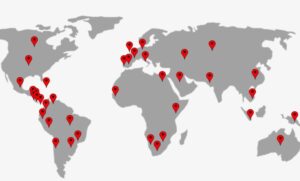The order Sirenia is constituted by four species of herbivorous aquatic mammals belonging to two families: family Dugongidae (Dugong dugong) and Trichechidae. The latter family is represented by manatees: Trichechus inunguis (2n = 56), T. senegalensis (2n = 48), and T. manatus (2n = 48) with a subspecies described in Florida (T. manatus latirostris) of the Antilles (T. manatus manatus). In addition, cases of first (2n = 52) and second generation (2n = 50) hybrids are described in the Amazon River mouth region. The status of these species is considered to be vulnerable, according to the IUCN (International Union for Conservation of Nature) red list. Several projects have been developed focused on ecology and conservation of manatee, however, genetic research for species occurring in the North Region is scarce. This research is the pioneer in the development of molecular cytogenetic analyzes with a focus on repetitive DNA and chromosome painting, where from the comparative analysis, the structural organization of the genome of marine manatee and Amazon species will be described, which are subject to hybridization. The frequency of hybridization is related to the reproductive, pre-zygotic and post-zygotic isolation mechanisms, by natural selection in order to avoid the occurrence of hybrids or are expected to be less viable in the environment. The chromosomal data are fundamental for the management of reproduction and conservation of the species. Besides, identification of occurrences of chromosomal rearrangements that are processes that generate genetic variability, having a fundamental role in the evolution of these animals.

- Society

Membership
Support our mission by becoming a member

Public Health Policy Center
Explore the society's public health initiatives

Meet the community
See what our members have been working on
- Journal
- Author Center
- Membership